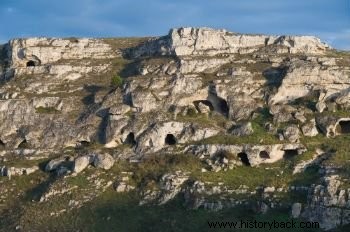The Paleolithic Period orChipped Stone Age It is the first period of Prehistory and, together with the Neolithic, make up the so-called “Stone Age”, since stone was the main raw material used in the making of tools. Note that the term Paleolithic means "old stone age" while Neolithic means "new stone age".
 Caves used in the Paleolithic Period, located in the region of Matera, Italy
Caves used in the Paleolithic Period, located in the region of Matera, Italy
The Paleolithic Period, considered one of the longest in history, (from the emergence of humanity, around 4.4 million years ago to 8000 BC) covers about 99% of the time of existence of human society, being divided into two moments:
- Lower Paleolithic (2000000 to 40000 BC)
- Upper Paleolithic (40000 to 10000 BC)
Prehistory
Prehistory is the first period of human history and is divided into three moments:
- Paleolithic Period or Chipped Stone Age (from the emergence of humanity, that is, the first hominids, until 10000 BC)
- Neolithic Period or Polished Stone Age (from 8000 BC to 5000 BC);
- Age of Metals (3300 BC to 1200 BC)
Key Features:Summary
During this period, the first tools were developed (knives, axes, harpoons, spears, bows, arrows, hooks), although there was not great sophistication in the production technique. They used the tools on a daily basis, for example, to collect fruits, roots, build small shelters or kill an animal.
Stone was the main raw material used and, unlike the Neolithic period (polished stone age), the Paleolithic represents the chipped stone age, a name that indicates the incipience and simplicity of the techniques used. Paleolithic instruments were made of stones, wood, bones and horns.
Nomadism was one of the main characteristics of Paleolithic man who walked most of his life in search of shelter and food. Men, who generally lived in bands, were hunters and gatherers, since agriculture and grazing only appeared in the later period (Neolithic), when individuals began to cultivate the land and domesticate animals.
Thus, since the man of that period did not produce food, that is, they did not plant or raise animals, the basis of food was the animals they hunted, the fish they fished and the collection of grains, roots and fruits; for this reason, Paleolithic men are classified as “hunter-gatherers”.
They did not build houses, they lived in caves to protect themselves from the weather (frost, rain, storms, etc.) as well as from animals. Undoubtedly, the greatest discovery made in this period was fire, after all with it men could cook their food, warm themselves and even scare away dangerous animals.
Certainly, the control of fire was one of the greatest achievements of this period. First, fire was found naturally, that is, by storm lightning. Later they discovered another method, through friction between stones or pieces of wood, which produced sparks.
Inserted in a hostile climate with accentuated climatic changes, the Paleolithic man began to develop techniques of protection for the body, that is, the clothes, produced largely with animal skins.
See also :Fire
Art in the Paleolithic Period
Paleolithic art encompasses the paintings made on rocks inside caves, called rock art and pariental art. There is a realistic and naturalistic character in the paintings, expressed by the figures of men and animals, as well as in the composition of abstract figures.
Learn more at:
- Art in the Paleolithic Period
- Art in Prehistory
- Prehistory:features and periods
